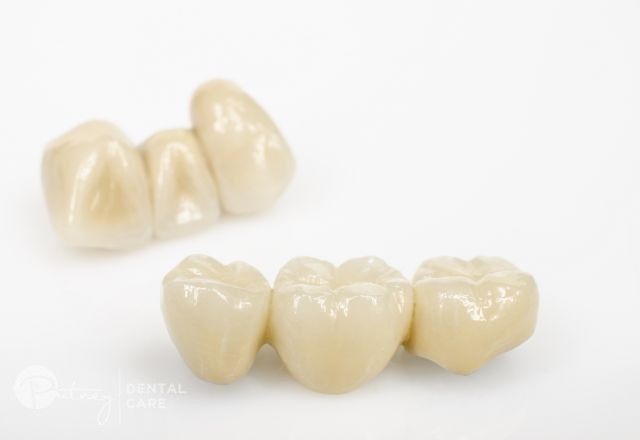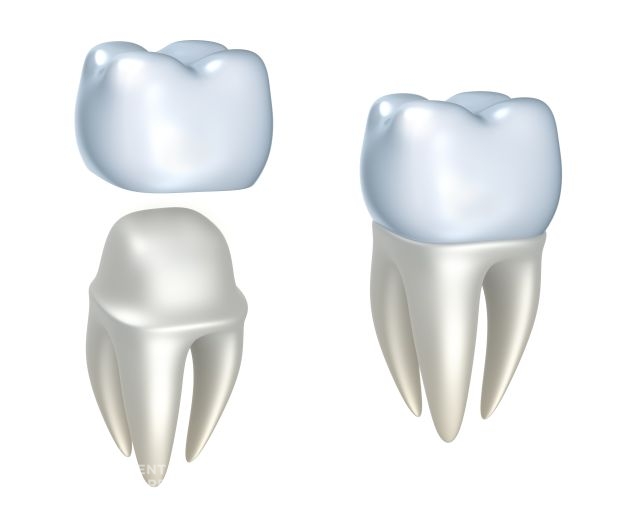Dental Crowns and Bridges

Despite how tough and durable tooth enamel is, it can still become chipped, cracked, and worn down over time. Trauma, tooth decay, fillings that are too large, root canals, and simple age-related wear and tear can all damage or compromise your teeth.
When this happens, an artificial crown is the best way to save the tooth and restore its form and function.
Crowns
Once a tooth is chipped or cracked, or is very decayed, it becomes susceptible to breaking. A crown effectively acts as a “helmet” that goes over a prepared damaged tooth and replaces the natural tooth crown.
In doing so the crown replaces the look, feel, and function of the tooth. It also improves the integrity of the tooth to prevent the chips and cracks from turning into breakages.
Bridges
Bridges are made out of several artificial crowns fused together to replace, rather than restore, one or more missing teeth. Typically a bridge is made out of three crowns, with the two at either end of the bridge being anchored onto healthy adjacent teeth to keep the bridge in place.
Both crowns and bridges can also be fixed to dental implants. This allows the complete replacement of a single tooth from the root up, and for bridges to be placed without compromising otherwise healthy adjacent teeth.
Materials
Metal alloy and porcelain are the most common materials used in crowns and bridges. Metal alloy provides the strength needed to withstand the biting forces at the back of the mouth. Porcelain closely mimics the look and colour of natural teeth, and is resistant to staining.
A combination of the two materials is also common, with a metal alloy base being covered by a porcelain coat for optimum strength and appearance.
It’s interesting to note that while many consider gold tooth restorations a fashion statement, gold is actually an excellent material for dental work. It’s tough, durable, biocompatible, and regularly lasts up to decades longer than other alternatives.
Crown and Bridge Process
All general dentists are trained and qualified to carry out crown and bridge restorations. Dentists can also choose to specialise in restorative treatments such as crowns and bridges. These specialists are known as prosthodontists.
Crown and bridges can take two or more appointments. The first appointment usually involves getting records of your bite and teeth, while the second is for actually fixing the restoration in place.
In certain cases more appointments may be necessary, such as if you require a root canal treatment first.
Recording the Bite
To ensure your crown or bridge accurately fits into your mouth, an impression is made of your teeth and bite. This is done by placing a jaw-shaped tray filled with soft gel into your mouth. You bite onto the gel, and an impression is made.
The purpose of recording your bite is twofold; firstly, it’s to make the tooth the correct size and shape to match the original tooth. Secondly, it’s to see how your teeth fit together when you close your mouth. Without knowing both of these pieces of information, the restoration won’t work properly and may even lead to further problems later.
Preparing a Crown
The tooth or teeth being restored are numbed, and 1-2 millimetres of enamel are shaved away. This is to allow space for the crown to sit over the tooth without encroaching on the teeth on either side.
After the tooth is shaved down, a second set of impressions are made. This impression, along with the first set, forms the basis for the dental lab to construct the restoration.
Manufacturing an artificial crown can take several days. In the meantime, a temporary crown is placed over the prepared tooth to protect it. This temporary crown is not as strong or durable as the finished restoration, so care will be needed when eating to prevent breakages.
At the second appointment, the temporary crown is removed and the new crown is placed into position. The dentist or prosthodontist checks to see if the size, shape, and colour matches the surrounding teeth. If so, the crown is cemented in place; otherwise it’s sent back to the lab for an adjustment.
Dental cement sets within an hour and fully hardens within a day. The crown should feel comfortable and natural in the mouth, without discomfort or adjustment necessary. If you feel anything unusual when the crown is tested, let the dentist or prosthodontist know before they cement it.
Preparing a Bridge
Preparation for a bridge is much the same as with a crown. The main difference is that healthy teeth on either side of the missing tooth are reshaped to allow the bridge to be mounted. The same process of impressions and adjustments are made for bridges as with crowns.
Hygiene and Care
Crowns and bridges can last for many decades with appropriate care, but there is no lifetime guarantee. It’s absolutely important to maintain good oral hygiene to prevent infections and deterioration of the restoration.
Your dentist or prosthodontist will advise you on how best to clean your crown or bridge. Where necessary, special cleaning tools such as floss threaders and “superfloss” might be given to you to aid in cleaning under a bridge.
Potential Complications
No restorative treatment is free of risk, even with the highest standards of practice. The following list is intended to inform, not alarm, and is not comprehensive:
- Breakages during preparation: It’s possible for a particularly damaged or decayed tooth to break while being prepared. This is rare, as thorough examination of the tooth should tell the dentist or prosthodontist whether the tooth will withstand preparation.
- Infection of the gum and pulp: Whenever enamel is shaved back, it runs the risk of infection to the gum or the inner pulp of the tooth. That’s why it’s important to be careful when you have a temporary crown prior to the cementing of the full restoration, and why proper cleaning is vital.
- Pain and discomfort: This should be temporary and last no more than two days.
Latest from the Dental Blog
 30 Oct 2015
30 Oct 2015
Pregnancy & Your Oral Health
Pregnancy will affect nearly every part of a woman’s life and her oral health is one of them. To try…
 16 Oct 2017
16 Oct 2017
Dental Crowns and Bridges
Despite how tough and durable tooth enamel is, it can still become chipped, cracked, and worn down over time. Trauma,…
 14 Feb 2018
14 Feb 2018
9 Best Dental Care Tips You Need to Know
A smile can brighten up everyone’s day. With proper dental care and oral hygiene habits, your smile can shine even…

